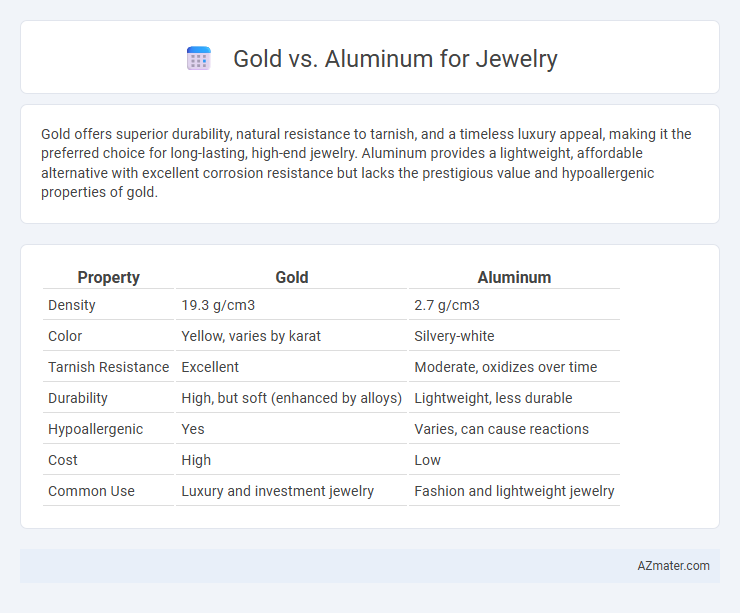Gold offers superior durability, natural resistance to tarnish, and a timeless luxury appeal, making it the preferred choice for long-lasting, high-end jewelry. Aluminum provides a lightweight, affordable alternative with excellent corrosion resistance but lacks the prestigious value and hypoallergenic properties of gold.
Table of Comparison
| Property | Gold | Aluminum |
|---|---|---|
| Density | 19.3 g/cm3 | 2.7 g/cm3 |
| Color | Yellow, varies by karat | Silvery-white |
| Tarnish Resistance | Excellent | Moderate, oxidizes over time |
| Durability | High, but soft (enhanced by alloys) | Lightweight, less durable |
| Hypoallergenic | Yes | Varies, can cause reactions |
| Cost | High | Low |
| Common Use | Luxury and investment jewelry | Fashion and lightweight jewelry |
Introduction to Gold and Aluminum Jewelry
Gold jewelry is prized for its exceptional durability, timeless luster, and hypoallergenic properties, making it a staple in fine jewelry collections. Aluminum jewelry is lightweight, corrosion-resistant, and offers a modern, affordable alternative with unique design possibilities due to its malleability. Both metals provide distinct aesthetic and practical benefits, catering to diverse style preferences and budget considerations.
Physical Properties Comparison
Gold exhibits superior malleability and resistance to tarnishing compared to aluminum, making it ideal for intricate jewelry designs and long-lasting shine. Aluminum is significantly lighter, which enhances comfort for larger or statement pieces but lacks the dense, luxurious feel of gold. Both metals offer corrosion resistance, yet gold's higher density and non-reactive nature provide greater durability and value retention in jewelry applications.
Durability and Longevity
Gold offers superior durability and longevity compared to aluminum due to its resistance to tarnish, corrosion, and wear over time. Its dense atomic structure allows gold jewelry to maintain its shape and shine even with daily use, while aluminum's softness leads to easier scratching and bending. For investment-value and heirloom quality, gold remains the preferred metal in jewelry durability and lasting beauty.
Weight and Comfort
Gold jewelry is significantly denser than aluminum, making gold pieces heavier and often perceived as more luxurious but potentially less comfortable for extended wear. Aluminum, with its low density of about 2.7 g/cm3 compared to gold's 19.32 g/cm3, offers lightweight comfort ideal for large or intricate designs without causing strain. The reduced weight of aluminum enhances wearability, especially in statement pieces, while gold provides a traditional heft associated with premium jewelry.
Price and Affordability
Gold jewelry typically commands a higher price due to its scarcity and higher market value per ounce compared to aluminum. Aluminum offers a more affordable alternative with its lightweight, corrosion-resistant properties, making it ideal for budget-conscious consumers. Choosing aluminum allows for stylish designs at a fraction of the cost of gold, without sacrificing durability or aesthetic appeal.
Hypoallergenic Qualities
Gold, especially in its pure 24-karat form, is highly hypoallergenic and suitable for sensitive skin, reducing the risk of allergic reactions compared to many other metals. Aluminum, while lightweight and corrosion-resistant, often triggers skin irritation due to impurities and alloys mixed in its composition. Therefore, gold remains the preferred choice for hypoallergenic jewelry, offering both safety and durability for sensitive wearers.
Design Versatility
Gold offers exceptional design versatility for jewelry due to its malleability and availability in various karats and colors like yellow, white, and rose gold. Aluminum, while lightweight and corrosion-resistant, is less popular for intricate jewelry designs because it is less malleable and typically limited to anodized color finishes. Jewelry designers prefer gold for complex settings and detailed craftsmanship, enhancing the elegance and customization potential of the pieces.
Maintenance and Care Requirements
Gold jewelry requires minimal maintenance due to its natural resistance to tarnish and corrosion, often needing only occasional cleaning with mild soap and water. Aluminum jewelry, while lightweight and affordable, demands more frequent care to prevent oxidation and surface discoloration, typically requiring polishing and protective coatings. Both metals benefit from proper storage in dry, airtight containers to extend their lifespan and maintain their appearance.
Environmental Impact
Gold mining consumes significantly more water and energy than aluminum production, leading to greater environmental degradation and habitat destruction. Aluminum often originates from bauxite mining, which also causes deforestation and pollution, but recycling aluminum reduces its environmental footprint more effectively compared to gold recycling. Choosing recycled materials minimizes energy use and waste, making recycled aluminum a more sustainable option for jewelry from an environmental perspective.
Choosing the Right Metal for Your Jewelry
Gold offers unmatched luxury and durability, making it ideal for timeless jewelry pieces and investment. Aluminum stands out for its lightweight comfort and corrosion resistance, perfect for casual or everyday wear without compromising style. Selecting the right metal depends on factors like budget, hypoallergenic properties, and the desired appearance in your jewelry collection.

Infographic: Gold vs Aluminum for Jewelry
 azmater.com
azmater.com